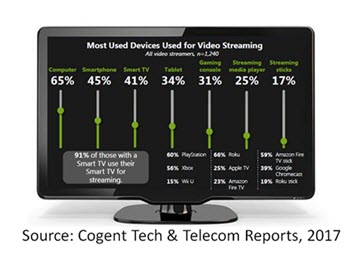Live TV Online -- Even Sports -- Is Not Attracting Audiences

Live video streaming has yet to find a significant audience, according to a just-released Cogent Reports study by Market Strategies International, which found that only 11% of streaming customers pay for live streaming video. Moreover, the analysis identified a preference for watching over-the-top streams on smart TV sets in homes with those devices, although smartphones are also popular.
In the context of recent deals (like the $1.5 billion plan for Verizon Wireless to stream National Football League games), the Cogent findings underscore the hopes and expectations of media companies.
Related: PwC Sees Sports Media Rights Overtaking Gate Receipts Next Year
"Live-stream TV features, such as real-time viewing and access to sports or local programs, don’t produce the same lift in reach that comes from improved navigation and expanded content," according to the report, titled "StreamOn." A sample of the report's findings is available here.
“TV providers are failing to recognize that the habits and needs of the viewer have dramatically changed, and the old rules of television no longer apply,” said Greg Mishkin, vice president of research and consulting at Market Strategies. “TV providers must evaluate and revise the business model to fit the needs of the consumer, because if they don’t, they are setting themselves up to fail.”
"Different needs" lead to various behaviors, according to Cogent's report. It identified three types of users: "Complementers," who pay for a streaming service in addition to traditional pay TV (about 53% of respondents,); "Supplementers," who cancel or downgrade traditional Pay TV (29%); and "Testers," who do not pay for streaming services but have tested various offers (19%).
Cogent's analysis also identified that computers, smartphones and smart TVs were the most-used devices on for streaming shows (see chart). In homes with a smart TV, 91% of streaming customers use that screen, but overall, computers are the favorite device (65% of consumers view videos on it), while 45% use smartphones -- substantially more than use tablets (34%), gaming consoles (31%), or streaming media players (25%) or sticks (17%).
The study includes customer satisfaction responses for quality, reliability and overall satisfaction (mostly in the 86% to 91% range) for Netflix, Amazon Prime Video and Hulu.
The broad popularity of streaming was underscored by the finding that 73% of respondents have used a paid streaming service; of the remaining 27% of respondents, 44% haven't used any streaming service and are unaware of any video streaming services (the report classified them as "out of category").
According to the report, the qualitative expectations around live streaming may be partly content-related: Some of today’s attraction to live streaming stems from the gaps in content on VOD streaming services, including the delay between the live air dates of network programs and their release dates on other services.
"This may explain the relatively low boost in reach associated with 'real-time/live viewing.'" said the study. "As usage patterns change, many are becoming accustomed to watching time-shifted TV, but the shift needs to be brief. If streaming providers figure out how to solve for that, live-streaming needs may change."
Using a "base-streaming service" priced at $10 per month appealing to 40% of its survey sample, Cogent found that local programming attracted only 4% more viewers, "real-time live viewing" added 3% and live sports added 2%.
Video Transcends "Commodity" Status
"Video is more than just a commodity," Cogent's analysis concluded.
It "facilitates" social and emotional needs, including family activity, relaxation, stress reduction, education and adventure, according to the report.
In its study, Cogent found that 48% of streaming customers often watch videos with others, and 22% frequently converse (multitasking) via social media while watching video streams. About two-thirds of streaming viewers often watch alone.
In a granular analysis of the potential streaming market, the report found that:
· 82% of respondents paid for a streaming service;
· 44% had "trialed" (tested) a streaming service;
· 32% had shared a streaming service; and
· 3% had both trialed and shared a service.
Multichannel Newsletter
The smarter way to stay on top of the multichannel video marketplace. Sign up below.
Contributor Gary Arlen is known for his insights into the convergence of media, telecom, content and technology. Gary was founder/editor/publisher of Interactivity Report, TeleServices Report and other influential newsletters; he was the longtime “curmudgeon” columnist for Multichannel News as well as a regular contributor to AdMap, Washington Technology and Telecommunications Reports. He writes regularly about trends and media/marketing for the Consumer Technology Association's i3 magazine plus several blogs. Gary has taught media-focused courses on the adjunct faculties at George Mason University and American University and has guest-lectured at MIT, Harvard, UCLA, University of Southern California and Northwestern University and at countless media, marketing and technology industry events. As President of Arlen Communications LLC, he has provided analyses about the development of applications and services for entertainment, marketing and e-commerce.



